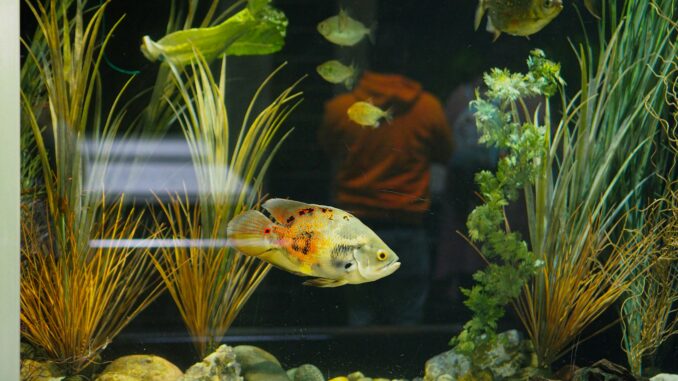
Setting up a beautiful, thriving aquarium is a rewarding challenge for any fish enthusiast. While many hobbyists focus on aesthetics or the variety of species they can keep together, a growing trend in the aquarium community is creating biotope tanks. A biotope tank is an aquarium setup designed to replicate a specific natural habitat, including the water parameters, plants, substrate, décor, and, of course, the fish species that naturally coexist in that environment.
This approach offers many benefits: it promotes healthier fish by providing them with an environment closest to their natural habitat, enhances the aquarium’s aesthetic authenticity, encourages natural behaviours, and provides an educational experience for the aquarist. In this article, we’ll take a deep dive into how to design and maintain a biotope-specific aquarium setup that authentically recreates your fish’s natural habitat.
What Is a Biotope Tank?
The word “biotope” refers to a region with uniform environmental conditions providing a living place for a specific assemblage of plants and animals. In aquarium terms, a biotope tank goes beyond simply housing fish and decor; it aims to mimic as precisely as possible the environmental and ecological conditions of a particular region or habitat in the wild.
Examples include the Amazon River Basin, East African Rift Lakes like Lake Malawi or Lake Tanganyika, Southeast Asian blackwater streams, or North American creeks. Creating a biotope involves replicating:
- Water chemistry: pH, temperature, hardness, and other parameters
- Substrate: sand, gravel, mud, or rocky bottoms
- Aquatic plants & décor: native plants, driftwood, rocks, leaves, etc.
- Fish and invertebrate species: native fish, shrimps, snails, and other fauna that coexist naturally
Why Choose a Biotope Tank?
1. Healthier Fish and More Natural Behavior
When fish live in conditions similar to their wild habitat, their stress levels reduce, immune systems strengthen, and they exhibit natural behaviors such as breeding, foraging, and territoriality.
2. Ecological Education
A biotope tank becomes a microcosm of a specific ecosystem, offering insight into how plants, animals, and environmental factors interact.
3. Unique Aesthetic Appeal
Biotope aquariums feature naturalistic visuals that often go beyond conventional “decor,” showcasing the beauty of specific habitats.
4. Conservation Awareness
By learning about habitats and species, aquarists can develop greater appreciation for wild conservation efforts.
Steps to Create a Successful Biotope Tank
1. Choose Your Biotope
Start by selecting a biotope that interests you and suits your experience level, tank size, and available resources. Popular biotopes include:
- Amazonian Blackwater: Soft, acidic water with tannin-rich blackwater, leaf litter, driftwood, and plants like Amazon swords and Echinodorus. Fish might include tetras, dwarf cichlids, and catfish.
- Lake Malawi (African Rift Lake): Hard, alkaline water; rock caves and sandy substrate; cichlids like Mbuna and peacock species.
- Southeast Asian Stream: Cool, clear water with rocky bottoms and fast currents; fish like Betta species and hillstream loaches.
- North American Woodland Stream: Cooler water with leaf litter, roots, and small stones; fish like darters and sunfish.
Research your chosen biotope in detail, noting water parameters, typical plants, substrate type, and fish species commonly found there.
2. Replicate Water Parameters
Water chemistry is critical for your fish’s health and biotope authenticity.
- pH: Amazonian biotopes often have pH 5.0-6.5, while African Rift Lakes may have pH 8.0-9.0.
- Hardness: Soft water versus hard water species.
- Temperature: Tropical biotopes usually range from 75-82°F (24-28°C), while temperate streams may be cooler.
Use water test kits to monitor your aquarium’s water and adjust as needed with buffers, peat, or remineralizers.
3. Select Appropriate Substrate and Decorations
Choose substrates that resemble those found in the natural environment:
- Sand: Favored in many riverbeds, African lake cichlid biotopes, and blackwater habitats.
- Fine gravel or mud: In slow-moving or bottom-rich streams.
Add natural décor elements such as:
- Driftwood: Provides shelter, tannins, and natural look, especially in Amazonian tanks.
- Rocks: Use locally sourced or aquarium-safe stones to mimic rocky shores.
- Leaf litter and seed pods: Oak or Indian almond leaves simulate the forest floor and release beneficial tannins.
Avoid artificial décor that clashes with the natural look.
4. Choose Native Plants and Animals
Plants help maintain water quality and provide shelter. Pick species native to your biotope:
- Amazon basin: Amazon sword, Vallisneria, Anubias.
- African Rift Lakes: Fewer plants in rocky zones but sometimes Vallisneria or certain algae.
- Southeast Asia: Microsorum pteropus (Java fern), Cryptocoryne species.
- North America: Elodea, pondweed, and native mosses.
Stock the fish based on species that naturally coexist. Avoid hybrid or non-native species that would be out of place.
5. Develop a Maintenance Routine
Biotope tanks usually benefit from:
- Regular water changes that simulate seasonal variations of the natural habitat.
- Monitoring water parameters to keep conditions stable.
- Control algae growth matching the biotope’s natural balance.
- Proper feeding tailored to the species’ diet.
Common Challenges and How to Overcome Them
- Water chemistry fluctuations: Use buffering agents and monitor parameters frequently at startup.
- Finding true native species: Research reputable breeders or specialty stores; wild-caught fish can be ethically questionable and risky.
- Maintaining plants: Some native plants are slow-growing and require patience and proper lighting.
Final Thoughts
A biotope tank offers a deeply rewarding way to enjoy aquarium keeping, combining scientific curiosity, creativity, and conservation. While setting one up requires more research and patience than a generic aquarium, the authentic beauty and lively ecosystem you create are well worth the effort.
With the right planning, attention to detail, and care, your biotope tank will become a miniature world where your fish thrive and your connection to nature grows stronger every day. Happy planting and fishkeeping!
Resources to Get Started:
- Books on biotope aquariums specific to your region of interest
- Online forums and communities for biotope enthusiasts
- Local aquarist clubs and specialty shops for sourcing plants and fish
Embrace the challenge, and enjoy the stunning results of recreating nature at home.
Leave a Reply
You must be logged in to post a comment.